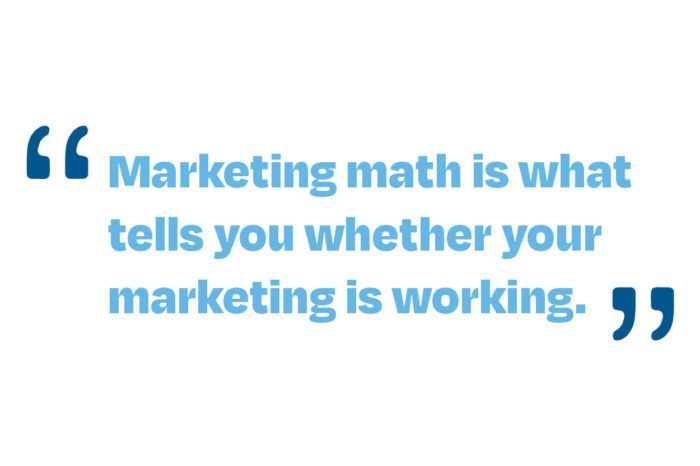As a business owner, you must develop an affinity for marketing math — or fake it as best you can.

That can be easier said than done if you’re not mathematically inclined (and most people aren’t). It can be even more complicated if you need help figuring out how to start.
First, let’s begin with the basics. What is marketing math, and why is it important?
Marketing math is what tells you whether your marketing is working. However, the proper calculations are likely different from what you’ve encountered in business finance.

You don’t need elaborate Excel formulas or lengthy breakdowns of complicated algorithms for marketing math. Marketing math only uses simple addition, subtraction, multiplication, and division. It’s used to evaluate numbers and see if your marketing efforts have yielded profitable results.
Knowing how to use marketing math is essential when running a small business. This is because most small businesses don’t have multiple accountants or marketing experts analyzing the ins and outs of their marketing strategy. Typically, a small business consists of an owner and a team of employees. So, with no one working to confirm if your marketing strategies are effective, it’s important that you are prepared to run your own calculations.
Similar to the math classes you likely took in high school, there are some key formulas you’ll need to memorize and be familiar with. You can use these formulas to check the progress of your marketing strategies, and each has its unique advantages and disadvantages.
These are the four main marketing math formulas you must know.
Return On Investment
If you’re not familiar already, your return on investment (ROI) is how much you earn back from anything you’ve spent money on.
For example, suppose you recently paid $2,000 to put up some signage around town. You’ll need to know how many customers visited your business because of those signs and how much money they spent. Was it more than $2,000? Less? Typically, you want the return on anything you’ve paid for to be more than your original investment.
This measurement is a simple way to tell if the marketing strategies you’re currently employing are worth your investment. If you’re investing more than what you get in return, it’s time to switch strategies.
To calculate your ROI, choose any period (like a month, week, quarter, or year) and subtract the amount invested from your revenue. Then, divide that number by the investment amount and multiply by 100 to see the return percentage.
Here’s an example.
Suppose revenue for Q1 was $75,000, and you invested $10,000 into your marketing. That would be $65,000 divided by $10,000, or 6.5, and then multiplied by 100. Your return on investment is 650% — great work!
Customer Acquisition Cost
Another key marketing math equation is your customer acquisition cost (CAC). This equation tells you how much it costs to acquire a new customer. This is helpful because it can determine the marketing strategies you can afford to employ.
To calculate your CAC, you need to add up all your sales and marketing expenses and divide them by the number of new customers for that given time frame. With sales and marketing costs, anything you spend to bring attention to your brand counts – including website maintenance costs, pay-per-click advertising, commercials, signs, and any money spent on your social media accounts.

Here’s an example: In 2021, you spent $210,000 on advertising and marketing and acquired two new customers every week, or about 104 new customers. That means each customer you gained that year cost your business approximately $2,019 to acquire.
Customer Lifetime Value (LTV)
Customer lifetime value (LTV) is the revenue you’ll acquire from each customer during their relationship with your business. Essentially, it’s a predictive measurement of your customers’ worth. But customers are people, not numbers, and can sometimes be unpredictable. Because of this, you’ll need a few metrics ahead of time to accurately calculate your LTV.
You’ll need your:
- Average Purchase Value – the average amount of a sale at your business over a period of time.
- Average Purchase Frequency – how often a single customer shops with you over a period of time.
- Average Customer Value – the Average Purchase Value times your Average Purchase Frequency.
- Average Customer Lifespan – how many years a customer shops with you.
Using these measurements, you calculate your LTV by multiplying your Average Customer Value by your Average Customer Lifespan. The hardest part about finding your LTV is collecting the necessary data. Some sales or KPI tracking software will collect this information for you. However, if you don’t have the technology to supply these answers, you can use rough averages over a given period.

Average Customer Value by your Average Customer Lifespan. The hardest part about finding your LTV is collecting the necessary data. Some sales or KPI tracking software will collect this information for you. However, if you don’t have the technology to supply these answers, you can use rough averages over a given period.
LTV is a key marketing math equation because of that CAC mentioned previously. If the lifetime value of your customers on average is $1,700 (meaning during their time as your customer, you will generate $1,700 in revenue from them) but your CAC is $2,019, you’re losing $319 on every customer. That means it’s time to reframe your marketing strategy.
Churn Rate
The last marketing math equation you need to know is how to calculate your churn rate. A churn rate, also called customer attrition, is the percentage of customers that leave your business.
Knowing this equation is important because it gives you an insight into your retention or customer experience. This is usually one of the first red flags to go up when a business begins failing. That’s because it’s a good indicator that your customers are unhappy and that whatever marketing strategies you’re using are not working.
To calculate your churn rate, take a set time frame and subtract the number of customers you have at the end of that period from the number of customers you had at the beginning. Then, divide that number by the number of customers you had in the beginning and multiply by 100 to see the percentage of customers who have left.
Let’s say you began 2019 with 3,000 customers and ended the year with 2,227. Following the equation above, your churn rate is 25.8%.
If this seems overwhelming, don’t worry. To make it easy, let’s emphasize just one of these equations to start with – CAC.
There’s a lot that goes into the acquisition of a new customer. Think of all the public advertising, marketing, promotion, and promotional discounts for the first transactions you have, then add in the percentage of your overhead that new customers represent. On top of that, even if you don’t take a salary, you still need to factor in the time you spend bringing in customers.
This is why we want you to start by focusing on your CAC – because the amount you must spend to get each new customer greatly impacts your marketing and the steps your business should take to cut costs and maximize profit.
Here’s a realistic example of how your CAC impacts every aspect of your marketing and business.
Marketing Math In Action
For example: Let’s say you assign yourself a hypothetical salary of $50 an hour as a reasonable baseline.
Now, add up all the expenses you have: maybe $15,000 a month on advertising (including $1,000 for the time you personally spend on marketing) and another $20,000 for customers who pay once and never return (representing about 30% of your $60,000 per month overhead).
That’s a total of $36,000 per month — and if that expenditure nets you 300 customers in a month, each customer costs you
to acquire.
But there’s more to it than that. It may cost $120 to acquire the customer, but failing to keep the customer costs more than just $120. The lost customer costs $240 because you’ll have to pay another $120 to replace them after already investing $120 to acquire them.
Additionally, most customers bring in at least one other customer through referral in a year. You will also miss out on that customer, bringing your total cost to $360. That’s the attrition cost, and it can be devastating for a company that’s trying to grow.
So how much could you spend each year on retention marketing and still come out ahead?
Well, if it costs you $360 every time you lose a customer you’ve acquired, you should be willing to spend up to $240 (the acquisition cost of a new customer). As a bonus, happier existing customers tend to spend more with you.
Retention and referral systems are investments that take your attention, time, money, and energy, but the math doesn’t lie — keeping customers you’ve paid to acquire and getting their referrals is a highly beneficial marketing strategy.

By now, hopefully, we have illustrated that marketing math is an invaluable tool for helping your business succeed. We encourage you to take the time to evaluate these metrics for your business and shift your strategy accordingly. It could be the difference between an amazing period of growth for your business and stagnation.
To learn more on this subject, you can purchase our founder’s book, “No B.S. Guide to Maximum Referrals & Customer Retention,” – available now from Amazon, Barnes & Noble, and other booksellers.
Want to learn more ways to increase your retention rates? Fill out the form below to download your free copy of our retention guide.


An outstanding share! I’ve just forwarded this to a co-worker who had been conducting a little homework on this. And he, in fact, bought me breakfast because I stumbled upon it for him… lol. So allow me to reword this… Thank YOU for the meal! But yeah, thanks for spending some time discussing this matter here.